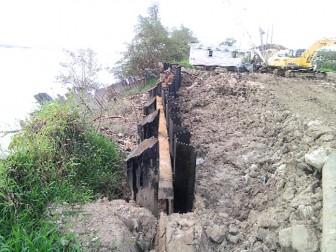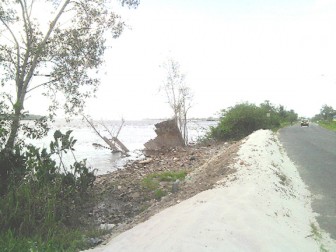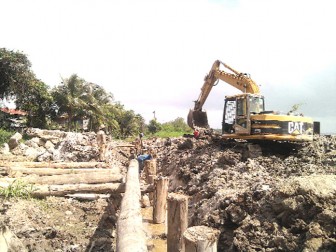Residents of Craig on the East Bank of Demerara (EBD) have reservations as regards river revetment in the area which is nearing completion while the authorities express satisfaction at the work being undertaken.
During the last quarter of 2010, the authorities green-lighted a $64M contract for works to be effected to the area and Government engineer, Walter Willis, told Stabroek News on Thursday that the contractor, M&B Construction, is working to complete the project shortly, noting that the infrastructure being built in the area is “relatively safe”. He said that the laying of sheet piles at the site was almost complete and he noted that the authorities will be watching the next spring tide, which is expected shortly, to assess its impact on revetment works at the site.

A similar project was undertaken in the area during the 1990s but the revetment had collapsed under the force of the river.
Chief River and Sea Defence officer, Geoffrey Vaughn, noted last week that a comprehensive assessment of the area would have been undertaken before works were ordered at the area earlier this year.
He said that the Sea Defence Unit has a record of the area and as such all works being undertaken would have been done with adequate knowledge.
During a visit to Craig last weekend, employees of the contracting firm told this newspaper that the company had another two to three weeks of work on hand as the area was being backfilled while a small trench located some distance from the 300m in revetment would be among the last aspects of the project before completion.
However, members of the Warner family, who along with a few other families have been feeling the brunt of flooding since they are living in close proximity to the river, noted that residents were keeping their fingers crossed where the prospect of the works being able to withstand flooding of the area is concerned.
Keeping an eye
They noted that since work started in the area last year, many persons had been keeping an eye on the infrastructure being built, noting too that the actual revetment appeared similar in height when compared to the previous structure which was constructed several years ago and had “fallen” into the river.

The new structure is being built less than a meter behind the older structure and an employee of the construction company noted that a small trench was expected to be built behind the newer structure, which he noted, will effectively assist in the area of drainage.
The works are being undertaken between 5 to 10 feet away from the shoreline and residents noted that while works were being undertaken there late last month, a spring tide which was in effect had seen some water seeping into the area but they noted that the revetment was not fully completed at the time.
A resident said that the new structure appeared to be able to withstand the force of the water over the next few years but he added that given the fate of the previously built structure, the area will continue to be threatened by the river. He noted that a more viable solution needed to be considered for Craig’s river defence in future.
Meantime, bids were recently tendered for construction to be effected farther south on the EBD at New Hope along the public road passing through the community which has eroded over time.
Two weeks ago, bids were opened at the National Procurement and Tender Administration Board (NPTAB), for works to be undertaken at the area. The engineer’s estimate for the works was provided as being $386M. This newspaper understands that the works will see a bypass being built in the area on the eastern side of the road while the area would be backfilled and piles would also be driven into the eroded section of the shoreline.
Sections of the EBD have been threatened in recent times during spring tides and there have been calls on the authorities to implement a comprehensive plan to protect the communities along the public road from the nearby Demerara River.
Watershed
The experts have predicted that flooding of areas alongside the river may be far from being solved while noting at the same time, that water from the Upper Demerara watershed, the consequence of heavy, persistent rainfall, which converges in the Demerara River may have dire consequences on the surrounding low coastal areas as flooding in several communities in Region 10 has demonstrated in recent time.

Engineer Malcolm Alli, had addressed the issue on a number of occasions in the letter columns of this newspaper and he said that work on the area has and will cost the authorities huge sums to address.
In the letter which appeared in the columns of this newspaper, Alli noted that in the 1960s there was some overtopping of the river dam at Craig and at Friendship which the Hydraulics Division monitored but since the Demerara Harbour Bridge was built in 1978 the problem of overtopping has become more acute, causing flooding and hardship to residents along the East Bank from Georgetown up to Friendship and beyond.
The Demerara River during low tide brings down a lot of silt from the upper reaches of the river, Alli noted, and because of the blockage of built-up silt under the supporting pontoons of the harbour bridge, the silt has backed up over a period of 32 years forcing the channel to move farther east, causing flooding in Craig and nearby areas. The siltation of the western bank of the river is visible to the naked eye upstream at low tide, he stated.
He said downstream of the bridge has also been affected and the recent high tide was measured at 3.64m, some 1.2m above the tidal amplification for Georgetown, and if correct he said it is indeed a very serious situation.
Calculations should be carried out first to ensure there is a factor of safety in the event of rotational slips in the dam at low tide before works can be undertaken to raise the sea defence in the area.
As a possible solution, he recommended river training works, which can deflect the channel farther west but this is expensive and depending on the amount of siltation, may not work.
He also said that digging a drain east of the dam to channel the water at low tide via the sluices may be a solution which is also expensive since people who have encroached on the reserve will have to be removed.
Another engineer had noted too that siltation of the river was the main issue which needed to be examined as it has been the cause of flooding along the river banks. He noted that the meandering profile of the river would cause a build-up of silt at turns along the river.
A Berbice-based group had also undertaken studies on the river and its effect on the nearby communities, and the group noted that it had created a blueprint of works which would see the land being reclaimed from the river. It was noted by the group, however that its plans were never considered by the authorities.









